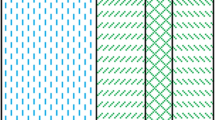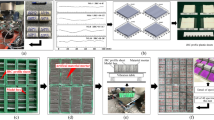Abstract
The majority of jointed rock mass failures mainly occur along the joints in shear mode, which promotes a wide investigation on the proposal of a reasonable and reliable shear constitutive model of rock joints. In this paper, based on Improved Harris function and laboratory shear tests, a new constitutive model of saw-tooth joints was proposed. Firstly, a series of laboratory direct shear tests were carried out on saw-tooth joint specimens made of rock-like materials (cement mortar) to obtain the shear stress-displacement curves. Subsequently, the test results were divided into sliding failure type and peak shear type according to whether there is a significant stress drop between peak stress and residual stress. It is assumed that rock elements can be divided into undamaged parts and damaged parts during the shearing process. The stress-displacement relation of the undamaged part satisfies Hooke’s law, while the damaged part provides residual stress. Via the comparison with commonly used micro-element failure probability density functions, the Improved Harris distribution function was selected as the standard to characterize the strength of micro rock units. Finally, derived from the theory of damage statistical mechanics, a damage statistical constitutive model was proposed, which can reflect the deformation characteristics of rock joints. Compared with previous models and experimental data, the model proposed in this paper can represent the trend of peak shear curve variation with higher accuracy, the parameters are easy to be solved and have obvious physical significance, which verifies the advantages and applicability of this model.













Similar content being viewed by others
References
Yang SQ, Chen M, Jing HW, Chen KF, Meng B. A case study on large deformation failure mechanism of deep soft rock roadway in Xin’An coal mine, China. Eng Geol. 2017;217:89–101. https://doi.org/10.1016/j.enggeo.2016.12.012.
Lin Q, Cao P, Cao R, Lin H, Meng J. Mechanical behavior around double circular openings in a jointed rock mass under uniaxial compression. Arch Civ Mech Eng. 2020;20:19. https://doi.org/10.1007/s43452-020-00027-z.
Lin H, Xiong Z, Liu T, Cao R, Cao P. Numerical simulations of the effect of bolt inclination on the shear strength of rock joints. Int J Rock Mech Min Sci. 2014;66:49–56. https://doi.org/10.1016/j.ijrmms.2013.12.010.
Goodman RE, Taylor RL, Brekke TL. A model for the mechanics of jointed rock. J Soil Mech Found Div. 1968;94:637–59.
Bandis SC, Lumsden AC, Barton NR. Fundamentals of rock joint deformation. Int J Rock Mech Min Sci Geomech Abstr. 1983;20:249–68.
Desai CS, Fishman KL. Plasticity-based constitutive model with associated testing for joints. Int J Rock Mech Min Sci Geomech Abstr. 1991;28:15–26.
Saeb S, Amadei B. Modelling rock joints under shear and normal loading. Int J Rock Mech Min Sci Geomech Abstr. 1992;1992:267–78.
Goodman RE. Methods of geological engineering in discontinuous rocks. Eagan: West Publishing Co; 1976.
Zhang C, Zou P, Wang Y, Jiang T, Lin H, Cao P. An elasto-visco-plastic model based on stress functions for deformation and damage of water-saturated rocks during the freeze-thaw process. Constr Build Mater. 2020;250:118862. https://doi.org/10.1016/j.conbuildmat.2020.118862.
Cao R, Cao P, Lin H, Ma G, Zhang C, Jiang C. Failure characteristics of jointed rock-like material containing multi-joints under a compressive-shear test: experimental and numerical analyses. Arch Civ Mech Eng. 2018;18:784–98.
Simon R. Analysis of fault-slip mechanisms in hard rock mining. Canada: McGill University; 1999.
Li Y, Oh J, Mitra R, Hebblewhite B. A constitutive model for a laboratory rock joint with multi-scale asperity degradation. Comput Geotech. 2016;72:143–51.
Zhou H, Meng F, Zhang C, Hu D, Lu J, Xu R. Investigation of the acoustic emission characteristics of artificial saw-tooth joints under shearing condition. Acta Geotech. 2016;11:925–39.
Zhang X, Jiang Q, Chen N, Wei W, Feng X. Laboratory investigation on shear behavior of rock joints and a new peak shear strength criterion. Rock Mech Rock Eng. 2016;49:1–18.
Zhang CY, Lin H, Qiu CM, Jiang TT, Zhang JH. The effect of cross-section shape on deformation, damage and failure of rock-like materials under uniaxial compression from both a macro and micro viewpoint. Int J Damage Mech. 2020;20:1–20. https://doi.org/10.1177/1056789520904119.
Han Z, Li D, Zhou T, Zhu Q, Ranjith PG. Experimental study of stress wave propagation and energy characteristics across rock specimens containing cemented mortar joint with various thicknesses. Int J Rock Mech Min Sci. 2020;131:104352. https://doi.org/10.1016/j.ijrmms.2020.104352.
Xia CC, Sun ZQ. Engineering rock joint mechanics. Shanghai: Tongji Press; 2002.
Oh J, Cording EJ, Moon T. A joint shear model incorporating small-scale and large-scale irregularities. Int J Rock Mech Min Sci. 2015;76:78–87.
Bian K, Liu J, Zhang W, Zheng X, Ni S, Liu Z. Mechanical Behavior And Damage Constitutive Model Of Rock Subjected To Water-Weakening Effect And Uniaxial Loading. Rock Mech Rock Eng. 2018;2018:1–10.
Yi L, Feng D. A damage constitutive model for intermittent jointed rocks under cyclic uniaxial compression. Int J Rock Mech Min Sci. 2018;103:289–301.
Wang ZL, Li YC, Wang JG. A damage-softening statistical constitutive model considering rock residual strength. Comput Geosci. 2007;33:1–9.
Li X, Cao WG, Su YH. A statistical damage constitutive model for softening behavior of rocks. Eng Geol. 2012;143:1–17.
Li TC, Lu LX, Zhang SL, Sun JC. Development and application of a statistical constitutive model of damaged rock affected by the load-bearing capacity of damaged elements. J Zhejiang Univ Sci A. 2015;16:644–55.
Cao WG, Wang JY, Yc Z. Study of simulation method for the shear deformation of rock structural planes and interfaces with consideration of residual strength. China Civ Eng J. 2012;45:127–33. https://doi.org/10.15951/j.tmgcxb.2012.04.001.
Xie SJ, Lin H, Chen YF, Yong R, Xiong W, Du SG. A damage constitutive model for shear behavior of joints based on determination of the yield point. Int J Rock Mech Min Sci. 2020;128:12. https://doi.org/10.1016/j.ijrmms.2020.104269.
Yang S, Xu T, He L, Jing H, Wen S, Yu Q. Numerical study on failure behavior of brittle rock specimen containing pre-existing combined flaws under different confining pressure. Arch Civ Mech Eng. 2015;15:1085–97.
Song C, Qiao C, Ye Q, Khan MU. Comparative study on three-dimensional statistical damage constitutive modified model of rock based on power function and Weibull distribution. Environ Earth Sci. 2018;77:108.
Cao WG, Xiang LI, Zhao H. Damage constitutive model for strain-softening rock based on normal distribution and its parameter determination. J Central South Univ. 2007;14:719–24.
Jian D, Gu D. On a statistical damage constitutive model for rock materials. Comput Geosci. 2011;37:122–8.
Huang H, Ju N, Li L, Xiao J, Li M, Bai J, et al. Improved Harris function based statistical damage softening model for rocks. J Eng Geol. 2018;26:520–6.
Xie SJ, Lin H, Wang YX, Chen YF, Xiong W, Zhao YL, et al. A statistical damage constitutive model considering whole joint shear deformation. Int J Damage Mech. 2020;29:988–1008. https://doi.org/10.1177/1056789519900778.
Lin H, Xie SJ, Yong R, Chen YF, Du SG. An empirical statistical constitutive relationship for rock joint shearing considering scale effect. CR Mec. 2019;347:561–75. https://doi.org/10.1016/j.crme.2019.08.001.
Flamand R, Archambault G, Gentier S, Joëlle R, Rouleau A. An experimental study of the shear behavior of irregular joints based on angularities and progressive degradation of the surfaces, 1994.
Tang ZC, Zhang QZ, Peng J, Jiao YY. Experimental study on the water-weakening shear behaviors of sandstone joints collected from the middle region of Yunnan province, PR China. Eng Geol. 2019;2019:258. https://doi.org/10.1016/j.enggeo.2019.105161.
Muralha J, Grasselli G, Tatone B, Blümel M, Chryssanthakis P, Jiang Y. ISRM suggested method for laboratory determination of the shear strength of rock joints: revised version. Rock Mech Rock Eng. 2014;47:291–302.
Tang ZC, Xia CC, Xiao SG. Constitutive model for joint shear stress-displacement and analysis of dilation. Chin J Rock Mech Eng. 2011;30:917–25.
Grasselli G, Egger P. Constitutive law for the shear strength of rock joints based on three-dimensional surface parameters. Int J Rock Mech Min Sci. 2003;40:25–40. https://doi.org/10.1016/S1365-1609(02)00101-6.
Weibull W. A statistical distribution function of wide applicability. J Appl Mech. 1951;18:293–7.
Basu B, Tiwari D, Kundu D, Prasad R. Is Weibull distribution the most appropriate statistical strength distribution for brittle materials? Ceram Int. 2009;35:237–46.
Chen LH, Chen ZY, Liu JM. Probability distribution of soil strength. Yantu Lixue/Rock Soil Mech. 2005;26:37–40.
Acknowledgements
This paper gets its funding from project (51774322) supported by National Natural Science Foundation of China; Project (2018JJ2500) supported by Hunan Provincial Natural Science Foundation of China. Project (2019zzts666, 2019zzts303) supported by the Fundamental Research Funds for the Central Universities of Central South University. The authors wish to acknowledge these supports.
Author information
Authors and Affiliations
Corresponding authors
Ethics declarations
Conflicts of interest
The authors declare no conflicts of interest.
Additional information
Publisher's Note
Springer Nature remains neutral with regard to jurisdictional claims in published maps and institutional affiliations.
Appendix A
Appendix A
In this appendix, we provide a detailed procedure for solving the parameters a and b.
By Eq. (13) to obtain the first derivative of the peak-strength point (up, τp) as follows:
The numerator of Eq. (19) is 0, that is:
Then the \( a^{2} b \times k_{\text{s}} {\tau_{\text{r}}} \left( {k_{\text{s}}{ u_{\text{p}}} - {\tau_{y} }} \right)^{2b - 1} \) term is eliminated from Eq. (20) to obtain:
According to Eq. (14), the following formula can be obtained:
Equation (22) can also be rewritten as:
Multiply both sides of Eq. (21) by \( {k_{\text{s}}} {u_{\text{p}}} - \tau_{y} \) to get a new equation. In this new equation, replace the \( a\left( {{k_{\text{s}}} {u_{\text{p}}} - \tau_{y} } \right)^{b} \) term with the \( {\frac{{k_{\text{s}} {u_{\text{p}}} - {\tau_{\text{p}}} }}{{\tau_{\text{p}} - {\tau_{\text{r}}}} }} \) term (see Eq. (23)), and the following formula can be obtained:
The above expression can also be written:
Eq. (25) can be simplified to:
According to Eq. (26), the model expression of b can be solved as follows:
Substituting Eqs. (27) into (28), the model expression of parameter a can be expressed as
Rights and permissions
About this article
Cite this article
Xie, S., Lin, H., Wang, Y. et al. Nonlinear shear constitutive model for peak shear-type joints based on improved Harris damage function. Archiv.Civ.Mech.Eng 20, 95 (2020). https://doi.org/10.1007/s43452-020-00097-z
Received:
Revised:
Accepted:
Published:
DOI: https://doi.org/10.1007/s43452-020-00097-z




